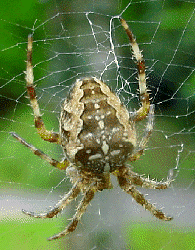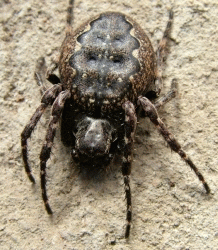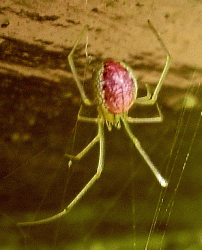INSECT FILES
Site Guide
Site Search
Home Page
Career Page
Insect Files
Shortcut to the main groups of insects and other arthropods...
Bug Rhymes & Poems
Links
Shop
Payments (credit/debit card)
|
Spiders (& Wind Scorpions) |
Class: Arachnida
Order: Araneae (& Solifuga) |
| 'Come into my parlour' - for a brief look at
spiders and similar arachnids . . . . . . |
|

Cave Spider (Meta menardi)
body up to 10-15 mm long
|
Like all arachnids, spiders differ from insects in having four (instead of
three) pairs of legs and in having only two (instead of three) distinct body regions - a hard
front part called the cephalothorax (or prosoma) and a soft hind part called the abdomen
(or opisthosoma) which are joined by a narrow stalk called the pedicel. Spiders are fairly
uniform in their general appearance (in most cases, apart from size, very like the example shown
opposite) and are so well known to most people that there is probably little or no difficulty in
their general recognition and overall distinction from most insects and other arthropods. |
|
|
|
Wind Scorpions (spider-like arachnids)
Among the arachnids, only the spider-like wind scorpions (Order Solifuga), sometimes called barrel
spiders or sun spiders, are likely to be confused with true spiders (Order Araneae). However, these
two groups can be easily distinguished since both the cephalothorax and abdomen of wind scorpions are
clearly segmented, whereas these body regions in true spiders are without obvious subdivisions. Wind
scorpions also lack spinning organs at the tip of the abdomen and thus cannot produce 'silk' threads
and spin webs as characteristic of true spiders. The illustration opposite shows a typical wind scorpion,
Galeodes, compared with a typical true spider, Araneus. The latter is very similar to the
cave spider pictured above. The wind scorpion shown here has extremely long palps which resemble an
extra pair of legs (the palps of arachnids are a pair of sensory appendages, usually quite short,
attached to the front of cephalothorax on either side of the mouthparts). All wind scorpions are
ground-dwelling arachnids, found mainly in steppes and deserts, and largely confined to tropical and
sub-tropical regions, whereas the true spiders are found in nearly all habitats and environments except
for the polar regions of the world. |

SOLIFUGA
Wind Scorpion
(Galeodes)
body up to 50 mm long |

ARANEAE
True Spider
(Araneus)
body up to 15 mm long |
| <<< TOP |
True Spiders
True spiders (Araneae) represent by
far the largest Order of the arachnids with about 35,000 species known worldwide. All are carnivorous
predators with powerful fangs, called chelicerae, which are used to bite and crush the prey, and to
inject venom. The chelicerae are attached to the front of the cephalothorax between the palps (a pair
of jointed sensory appendages). The prey of spiders largely consists of insects and other arthropods
(including other spiders), but some of the large, tropical species will also attack small frogs,
lizards and even birds. Many of the spiders found commonly in farmland and gardens, particularly the
so called money spiders (members of the family Linyphiidae) and wolf spiders (members of the family
Lycosidae), are considered beneficial natural enemies, since they often prey on aphids, leafhoppers,
gall midges, stem- and root-boring flies, cutworm moths and other undesirable insect pests of crop
and garden plants. |
| <<< TOP |
Spider Webs
Apart from the construction of webs
as snares for trapping prey, spiders also use silk for other purposes, e.g., for producing egg sacs,
for wrapping and immobilizing prey, for constructing retreats in which to shelter, for dispersal on
air currents and as safety lines when jumping or dropping to the ground. Spider silk is a protein
material and is produced by glands in the spinning organs near the tip of the abdomen. The silk used
for web-building is often provided with adhesive droplets which help trap and entangle any captured
prey.
The webs familiar to most people are the large orb webs constructed by many of our
commonest spiders and often seen adorning recessed corners of buildings, sheds and fences or suspended
between the shoots and branches of garden and hedgerow plants. However, the webs of different spiders
show great variation in structure - some species merely spin irregular sheets over soil, foliage and
other structures (commonly called 'cob-webs'), many construct funnel-shaped webs often associated with
holes in walls, fence posts and tree bark or with gaps under logs and stones, others produce tent-like
structures among plant foliage, whilst a few species spin triangular or star-shaped webs. The variety
is almost endless! Within a given species, no two webs are ever identical and even the webs of an
individual spider may vary depending on its age and surroundings. |

Example of an Orb Web
Photo: I. Britton - FreeFoto © |
|
Webs, especially orb webs, are often damaged by flying insect prey and bad
weather, and sticky webs, even if undamaged, generally loose their adhesiveness after a day or two.
Hence, the majority of spiders are forced to repair and rebuild their webs more or less on a daily
base. However, nothing goes to waste in this process since spiders can rapidly recycle the protein
of silk by eating the old or damaged web before a new one is made. |
| <<< TOP |
Spider Dispersal
Spiders generally move from
place to place by walking and this is the only way that large spiders can disperse to find new
habitats. However, the newly hatched young (spiderlings) of many large spiders, and both the adults
and spiderlings of small species, can move more quickly to new areas by air. This arial dispersal is
commonly called 'ballooning'. The spider first crawls to the top of vegetation or other convenient
structure, stands on 'tiptoe' with the abdomen pointing skyward, and then releases strands of silk
from its spinning organs. Eventually, perhaps after several tries, the silk threads are caught by
the breeze and carried upwards on rising air currents. A small spiders is very light and when the
pull of the air current is sufficiently strong, it lets go its foothold and sails aloft into the air.
In this way spiders may be carried many miles before descending back to earth. Aerial dispersal,
whilst undoubtedly very effective, does have its disadvantages. Ballooning spiders are fair game for
many insectivorous birds, such as swallows, and may be eaten, or the spiders may be carried out to
sea or into lakes and get drowned, or may land in some other unfavourable environment. Nevertheless,
large numbers of ballooning spiders evidently manage to survive these risks, judging by their
rapid colonisation of fresh habitats, as frequently observed in newly planted farm crops. |
| <<< TOP |
Spider Bites
All spiders bite and nearly all
inject venom into their prey, but the fangs of the vaste majority of species are too small to
penetrate human skin and very few will bite man, even when severely provoked. Of the 35,000 or so
species throughout the world, about 500 are known to cause painful bites in humans, but only about
a dozen of these spiders are highly venomous. The species which are particularly dangerous to man
are largely confined to warmer parts of the world, although their common names will be familiar to
most people. For example, the venomous bites of the black widows or red-back spiders (Latrodectus)
and the Australian funnel-web spiders (Atrax) are well known, since both can be fatal in some
circumstances. Likewise, the Brazilian wandering spider (Phoneutria) has a dangerous reputation
as a very aggressive species with an extremely painful bite. Few, if any, of the spiders found in
temperate regions are particularly venomous or likely to bite. Among the native spiders of Britain
and northern Europe, for example, there are only one or two species that require some caution if
handled. The water spider (Argyroneta) can give a fairly painful bite, but usually this
is much less severe than the bites and stings of many common insects. Somewhat unpleasant bite
wounds can also be inflicted by the larger species of Cheiracanthium and Steatoda.
The latter species is often found in and around house and other buildings. You can find more about
the recognition and biology of these and other spiders from the books listed below. |
| <<< TOP |
Spider Gallery |

Wolf Spider
(Lycosidae: Lycosa species)
body up to 8 mm long
Photo: J. Kalisch - UNL © |

Cellar Spider
(Pholcidae: Pholcus phalangioides)
body up to 10 mm long
Photo: J. Kalisch - UNL © |

Woodlouse Spider
(Dysderidae: Dysdera crocata)
body up to 15 mm long
Photo: J. Kalisch - UNL © |

Tubular Web Spider
(Segestriidae: Segestria florentina)
body up to 22 mm long
|

Common House Spider
(Agelenidae: Tegenaria domestica)
body up to 10 mm long
Photo: J. Kalisch - UNL © |

Giant House Spider
(Agelenidae: Tegenaria duellica = T. gigantea)
body up to 16 mm long
Photo: D. Hagon © |

Cave Spider
(Tetragnathidae: Meta menardi)
body up to 15 mm long
|

Nursery Web Spider
(Pisauridae: Pisaura mirabilis)
body up to 15 mm long
|

Crab Spider
(Thomisidae: Synaema globosum)
body up to 8 mm long
Photo: S. Hyde © |

White Death Crab Spider
(Thomisidae: Misumena vatia)
body up to 11 mm long - white form
|

White Death Crab Spider
(Thomisidae: Misumena vatia)
body up to 11 mm long - yellow form
Photo: J. Kalisch - UNL © |
Identification Guides (Europe)
- Jones RD. 1983. The Country Life Guide to Spiders of Britain and Northern Europe.
London, Hamlyn.
- Locket GH, Millidge AF. 1951. British Spiders, Vol I. London, Ray Society.
- Locket GH, Millidge AF. 1953. British Spiders, Vol II. London, Ray Society.
- Locket GH, Millidge AF., Merrett P. 1974. British Spiders, Vol III. London, Ray Society.
- Roberts MJ. 1993. The Spiders of Great Britain and Ireland. Compact Edition, Vols 1-3.
Colchester, Hartley Books.
- Roberts MJ. 1995. Spiders of Britain and Northern Europe. Collins Field Guide. London,
HarperCollins.
General Reading
- Bristowe WS. 1958. The World of Spiders. New Naturalist Series. London, Collins.
- Chinnery M. 1993. Spiders. London, Whittet Books.
- Foelix RF. 1982. Biology of Spiders. London, Harvard University Press.
- Hillyard P. 1994. The Book of the Spider. London, Hutchinson.
- Preston-Mafham R. 1991. Spiders, an Illustrated Guide. Poole, Blandford.
- Preston-Mafham R, Preston-Mafham K. 1984. Spiders of the World. Poole, Blandford.
|

(classification of arachnids) |
|
<<< TOP |
(use the back button on your web browser to return to the previous page) |
TOP >>> |

|
|

















